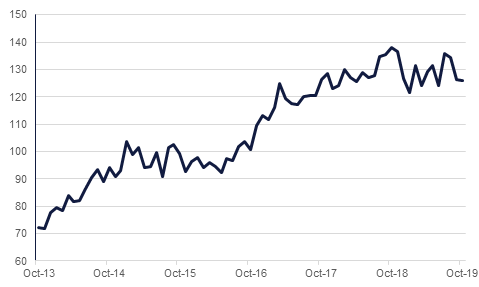
UK PM Boris Johnson finally got something he wanted overnight, namely support for a general election on December 12th. This will be the third time the UK has gone to the polls to choose a new government since 2015, and is an attempt to break the deadlock that has emerged in a split Parliament over Brexit. More than this it will be a critical election that will shape Britain’s future for many years to come. The Conservative party leads in the opinion polls currently on close to 40% with opposition Labour party second on around 25%, and with a number of smaller parties below this, but a lot can change before polling day.
After nearly two weeks of protests, embattled Lebanese Prime Minister Saad Hariri announced his resignation yesterday. Concessions and a new fiscal plan announced last week were not enough to satisfy the protesters. A decline in bank deposits this year as growth has stalled and fears over a currency devaluation had brought Lebanon to the brink of crisis, even before this latest unrest. A more concerted government effort to address the perceived economic mismanagement is clearly welcome, but there will be no easy solutions.
Saudi Aramco reportedly is targeting November 3rd to begin its IPO process with an aim of beginning trading on the Tadawul by December 11th. An overseas listing remains an ambition for the company but so far the company has been unable to select a foreign exchange. The prospect of the Aramco IPO had placed an unofficial ‘put’ under the oil market as the government of Saudi Arabia would seek to achieve a maximized valuation. Once the IPO is out of the way, oil markets may need to find a new anchor which may end up being at a lower level given the distressed fundamental outlook for 2020.
The UAE has passed a federal government budget of AED 61bn for 2020, a 1.2% increase from the 2019 budget. The federal government budget is usually balanced, and in 2018 accounted for approximately 15% of the consolidated UAE budget.

Source: Bloomberg, Emirates NBD Research
US treasury yields dipped lower as the FOMC meeting got underway. Yields on 10yr USTs fell nearly 2bps while the whole of the curve pushed lower. Waning expectations of a US-China trade deal being reached by the time the US and Chinese presidents meet in November helped to tame risk appetite while weaker consumer confidence in the US likely increased the concern that the Fed’s pending rate cut may indeed be necessary as an insurance cut.
Regionally the focus remains on Lebanon where the resignation of the prime minister hasn’t tempered fixed income anxiety about the country. The sovereign five year CDS continues to march higher as there appears to be no pending resolution to the political crisis.
GBP rallied a little overnight on the news that a general election will be held in the UK on December 12th, in the hope that the three year deadlock over Brexit might finally be approaching an end. However, its gains were limited as the outcome of the election is unclear and the possibility of an anti-capitalist Labour government led by Jeremy Corbyn is unsettling for markets. Elsewhere, currencies are generally firm at the USD’s expense as the markets await the outcome of the Fed’s FOMC meeting, where a 25bp rate cut is widely expected. The Bank of Canada is also setting monetary policy today with the expectation being for an unchanged decision.
Equity markets were largely stable at the start of the week, ahead of the US Fed’s interest rate decision later today. The S&P declined 0.1% from its record high recorded Monday, while the FTSE lost 0.1% and the DAX was flat.
Regional equities closed down, with the DFM, the ADSM and the Tadawul losing 1.4%, 1.2% and 1.2% respectively.
Oil markets remain on the back foot as demand considerations are driving prices lower. WTI fell nearly 0.5% overnight and is down by around the same amount already, trading at USD 55.29/b. Brent futures are close to expiry and were around flat overnight but have given up 0.3% in trading today to touch USD 61.40/b. Commentary from Russian officials suggest they will not support a deeper production cut when OPEC+ meets in December even as the idea is reportedly being mooted by some OPEC officials.
API data showed a build in US stocks at the Cushing, OK delivery point of 1.2m bbl last week. Official data from the EIA will be released later today.